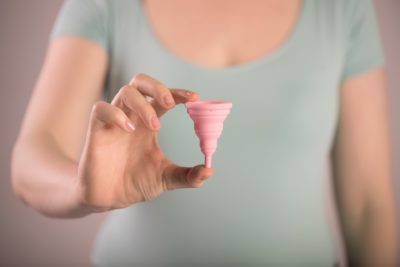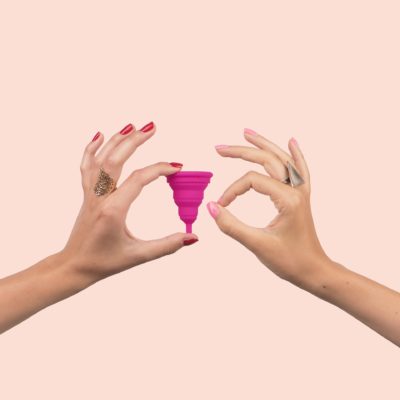
As a part of a group that talks about sustainable menstruation, one of the most common question that is asked by newbies or those who want to move to a cup is ” How long does a menstrual cup last?”A very valid question because it has been marketed like one of the most durable products in the world.
One of the most convenient accessories that made periods more easier is certainly the menstrual cup. Offering an experience of sustainable and green periods, menstrual cups is something more women have been opting for in the past few years. When I moved to a cup four years ago, I knew I wasn’t going to move back to using sanitary napkins. I knew that this was one step to my contribution of living a greener life and not contributing to the landfill.
Did you know that a sanitary napkin takes an average of 400 years to decompose? Sometimes more. And on an average a woman discards roughly 100 kilos of sanitary waste in her lifetime. So, you can estimate the amount of landfill that is caused.
One of the main hurdles a woman faces when she wants to move to a sustainable option is the lack of information. This post is all about menstrual cup and how long does the menstrual cup last.
How long does a menstrual cup last?
From 5 years to 12 years, a quick search on the internet will show these results and more. The average life-cycle of most menstrual cups is 6-8 years and for those who are not aware might find it a bit of a stretch. The truth is that there is no correct answer on how long does a menstrual cup last. Each menstrual cup will last a few years and it also depends on how you take care of it. So cleaning the cup, storing it and using it the right way will make your menstrual cup last longer.
Diva Cup on its site has mentioned, “Silicone is very durable, but we recommend that you inspect your cup regularly for signs of deterioration such as a sticky or powdery film, severe discoloration or odor, etc. If you detect any of these signs or if you experience irritation we recommend you replace your DivaCup with a new one. Depending on the factors unique to each woman, like vaginal pH, how well and often the cup is cleaned, what cleansing agents are used, etc., the lifespan may vary. Since The DivaCup is a personal hygienic product, a general guideline is to replace it once a year, but ultimately, it is up to the consumer to decide when it is necessary to replace the cup.”
What are the different ways to ensure your menstrual cup lasts longer?
Women I know have been using their menstrual cups for 4 years and longer. I have been using mine for the past 4 years and I don’t see buying a new one for the next one year at least. One of the most common problems you see in the menstrual cup is the discoloration that happens in about two years of using it. Your menstrual blood will stain the silicone material even if you are cleaning it regularly.
Must Read: How to clean a menstrual cup
But just a little bit of discolouration should not be the reason for you to change the cup. That is unlikely to affect the quality of the menstrual cup. Some signs that indicate you need to change the menstrual cup are:
- extreme discoloration despite having cleaned the cup thoroughly
- a bad odour that persists even after you have sterilized the cup
- a film of a powdery substance that you see after it has dried
- it feels sticky to the touch even when it is dry
How do you keep your menstrual cup clean?
In order to make your menstrual cup last as long as possible, you have to clean it before and after every period cycle. The cleaning is more than using a wet wipe or rinsing it under warm water with a soap free solution.
Sterilize it: Clean your menstrual cup by dunking it in a pan of boiling water and keeping it in the pan of boiling water for at least 10 minutes.
Cleaning the holes: Most menstrual cups have holes and you can insert a pin or a toothpick to remove any remaining residue in it.
Cleaning it when you use it: When you are using the cup, wash it thoroughly after you empty it. Use a mild soap free wash to clean it before you insert it again.
Storing it: After you sterilize it, place it on a soft towel and let it dry completely before you store it in a breathable cotton bag.
Must Read : Why did I opt for a menstrual cup?
Do this every month to ensure that your menstrual cup is clean to use to avoid any infections. Always inspect the menstrual cup in the sunlight at least once in three months to look for signs of a bad odour or any residue. If you do find either or a combination of these, its time to change the menstrual cup.
So, when is it that you need to change the menstrual cup? If your cup smells, looks discolored, or feels sticky despite sterilization, you need to change your menstrual cup.
[amazon_link asins=’B00TQPM2E2,B0747LJ4JZ,B06XXXTYMB’ template=’ProductCarousel’ store=’pratsm-21′ marketplace=’IN’ link_id=’b670ab34-1869-11e8-8d15-9bf3880d84b7′]
Follow Me On…
FACEBOOK | TWITTER | PINTEREST |elephant journal |INSTAGRAM |QUORA
*All of my reviews are based on my own personal experiences with the brand/products. If it is a sponsored post, it is indicated. Most of the brands and products reviewed are what I have tried and tested and truly recommend! All Photographs are (C) Pratibha unless stated otherwise.*

Leave a Reply